Ever wonder what goes into building a team? There are so many approaches to building a team that can compete in the Stanley Cup Playoffs. Some teams look to build a big, physical force that wears down their opponents. Some choose to build for speed and the ability to score at will. Those are the simplistic views, but a lot more goes into it than that.
Some teams are built up of a group of players that many general managers had a hand in choosing. Some are build straight through the draft and some teams decide to trade for their talent.
To take a closer look at how teams are built, this will be the first of many articles dedicated to the construction of teams. We will take looks at the tendencies of general managers and how they manage their teams and the contracts they hand out as well as how successful they are in the three main areas of acquiring players.
Let’s start with the Dallas Stars, one of the most interesting teams in terms of how they appeared this past season.
A few quick notes before moving on.
-All statistics are while playing 5-on-5 unless otherwise indicated.
-Statistics and combined statistics are only counted for players who played at least 100 5-on-5 minutes in the 2015-16 regular season.
-Statistics are courtesy of corsica.hockey, war-on-ice.com, nhl.com, and capfriendly.com
How Were They Acquired?
Players Drafted in Dallas, Playing in Dallas (Colton Sceviour, Jamie Benn, Jamie Oleksiak, John Klingberg, Patrik Nemeth, Radek Faksa, Valeri Nichushkin, Jyrki Jokipakka)
Outside of a couple outliers like Sceviour and Klingberg, the Stars have really drafted for size in the past six years or so. With an average height of over 6’3” and an average weight of over 213 pounds, it is easily the biggest group of the three main acquisition types. It is also the youngest, with an average age of under 24 years old.
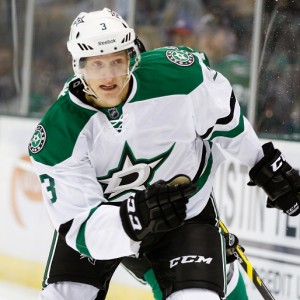
These players were drafted all over the board, with two of the most successful picks (Benn and Klingberg) coming in the fifth round. As a whole, this group’s average draft round was in the first eight picks of the third round. With many of those players still on early contracts, their overall cap hit is incredibly beneficial to the team. That group averages a cap hit of just over $1.83 million per season.
What you’ll notice about this group is some inconsistencies as far as making the lineup goes. Oleksiak was in and out of the lineup. Nemeth was in and out of the lineup. Jokipakka was in and out of the lineup and then traded at the deadline. Sceviour and Nichushkin absorbed some healthy scratches throughout the season. Faksa didn’t really start playing significant minutes until late in the year and into the playoffs. The only two players who played more than 1000 minutes of 5-on-5 play in this group were Benn and Klingberg. Overall, the drafted players made up for just over 31% of 5-on-5 ice time this season.
That ice-time translated well into the rest of the statistics amassed by this group. They scored almost 27% of goals and just under 32% of points for the Stars this past season. They racked up a fair amount of points via the secondary assist, resulting in the group of draftees scoring just over 29.5% of primary points this season. That group made up for over 37.5% of secondary assists over the course of the season.
The draftees of Dallas were excellent at pushing the possession meter this season. They finished the regular season with a combined CorsiFor% (CF%) of 53, significantly better than the free agents of Dallas and just under players that were acquired via trade. Consistent with their ice-time, the drafted players made up for 31% of individual shot attempts this season.
One thing this group did better than anyone else on the team was manufacture scoring chances of the “high-danger” variety. Their combined 52.9 HighDangerScoringChancesFor% (HSCF%) was over 2% higher than the free agent group and almost 2% higher than the trade group. They averaged almost a full high-danger chance per 60 minutes of play over the other two groups. Nishushkin was the only player in the group of draftees who finished under 50% in HSCF%. They managed to put up over 35% of individual high-danger chances overall.
Free Agents Signed in Dallas (Ales Hemsky, Antoine Roussel, Johnny Oduya, Jordie Benn, Patrick Eaves, Vernon Fiddler)
This one is an interesting group. You’ve got your rag-tag group of undrafted players with Roussel, Benn, and Fiddler. Then you’ve got your proven veterans in Hemsky, Eaves, and Oduya. Eaves and Hemsky were both former first-round draft picks while Oduya was drafted in the seventh round. Predictably, this group had the highest average age coming in at just over 31 years old. They were also the smallest group, with an average height of just over six feet and an average weight of 197.5 pounds.
Unlike many teams who fall victim to overpaying in free agency, the Stars have kept their free agent signings relatively cheap. Hemsky is the largest contract at a $4 million cap hit and the group of six average a cap hit of just over $2.14 million. That’s decent value for what amounts to be a group of mainly role-players.
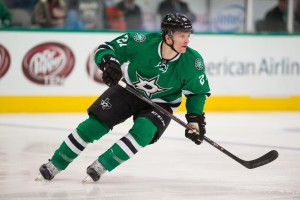
Being a group made up of a few role-players, their overall ice-time is lower. This group made up for just under 5300 5-on-5 minutes this season, just over 27% of the total ice-time of the three groups combined.
Looking at the players who make up this group, it isn’t surprising to see that they averaged over 286 defensive-zone-starts each. That is a significant jump over the draftees (average of 233.5) and the acquisitions by trade (247.4). Their combined offensive-zone-start-% (Offensive zone starts/offensive zone starts+defensive zone starts) was 49.23, the lowest of the three groups. They were primarily used as defensive players throughout the season.
How did they fare in those responsibilities?
It’s a mixed bag. Hemsky and Eaves both played well, keeping the puck out of their own end and into their opponent’s. Roussel struggled mightily for a good chunk of the season until he was put with Faksa and Hemsky. The total group averaged a Corsi-Against-per-60 of 55.87, higher than the other two groups. They still managed a combined CF% of 51.23, a respectable number considering all of the defensive zone starts.
Offensively, they produced well enough, especially when you look at the group of players assembled by free agency. The main offensive threat in that group is Hemsky and after that, there are depth role-players and defensive-defensemen. Still, that group produced over 22.5% of goals scoring playing 5-on-5 this season and just under 22.5% of primary points. That group racked up a combined 100 total points playing 5-on-5, good for about 23% of the points scored by the team this season.
Players Who Arrived in Dallas Via Trade (Alex Goligoski, Cody Eakin, Jason Demers, Jason Spezza, Mattias Janmark, Patrick Sharp, Stephen Johns, Travis Moen, Tyler Seguin, Kris Russell)
That’s an impressive list and full of players who play important roles on the team. They’re still a relatively young group with an average age of just over 28 years old despite adding veterans such as Spezza, Sharp, and Moen. They have an overall average height of 6’1” and an average weight of just under 200 pounds. They certainly aren’t huge aside from a couple of outliers such as Johns and Spezza.
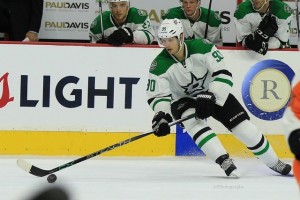
Both Jim Nill and Joe Nieuwendyk have done an excellent job capitalizing on other teams’ high draft choices. With all of those players combined, the average draft round is three with Spezza and Seguin both being second overall picks in their respective drafts. That hasn’t come cheap, as this group of players possess an average cap hit of $3.5 million per season.
While they may cost a bit more, the players in this group have been offensive forces for the Dallas Stars. The 82 goals they scored 5-on-5 made up for more than 50% of the total goals scored by the team this season and their 152 primary points were good for almost 48% of that category.
Just three in that group of ten finished the season under 50% in CF% and they were players with largely defensive roles (Eakin, Johns, Moen). The group combined posted a 53.23 CF% and played a significant amount of minutes in the offensive zone. They did average the highest offensive-zone-start-% with 52.62%. They had 800 more offensive zone starts than the second-highest group. Ice-time is a big reason for that, as this group made up for almost 42% of the team’s total ice-time this season.
The scoring chances this group put up ended up translating directly into the goals and points they amassed throughout the season. They had a combined SCF% of 53.66 and a combined HSCF% of 51.05. The group of traded-for players had almost 45% of individual scoring chances put up by the three groups this season as well as over 43% of high-danger chances. They made the chances they got count more often than not.
Who Acquired Them?
Doug Armstrong (Jamie Benn, Colton Sceviour)
Yes, that Doug Armstrong.
Armstrong has two acquisitions left on this current version of the Dallas Stars and one of them has had a major impact on the present state of the club. Benn has become the captain of the Stars and one of the best players in the NHL.
Armstrong took both Benn and Sceviour in the same draft in 2007. Sceviour actually went before Benn that year with Sceviour going in the fourth round and Benn falling to the fifth. They have extremely different roles on the current Dallas Stars and their salaries reflect that. Their average cap hit between the two of them is $2.95 million per season.
Armstrong’s draft choices have had a lasting impact. Despite making up for less than 10% of total 5-on-5 ice-time this season, Benn and Sceviour have produced well at even-strength. They scored almost 16% of goals and 14% of primary points with Sceviour not being as far behind Benn as you’d think. Benn had 29 primary points while playing 5-on-5 this season while Sceviour chipped in 15 of his own.
They were two of the better Stars in terms of creating quality chances. Their 140 combined high-danger chances added up to over 17% of the total amassed by the Stars this season. Their combined HSCF% ended at 52.73, better than both Nieuwendyk’s acquisitions and Nill’s. Though a number of players are small in number, Armstrong’s impact on the Dallas Stars still remains large.
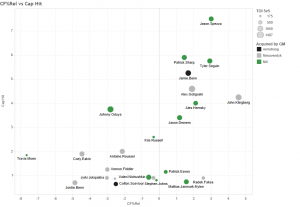
Joe Nieuwendyk (Jamie Oleksiak, John Klingberg, Patrik Nemeth, Radek Faksa, Jyrki Jokipakka, Antoine Roussel, Jordie Benn, Vernon Fiddler, Alex Goligoski, Cody Eakin)
Nieuwendyk has been largely criticized for his work in Dallas, especially when it comes to first-round draft picks that haven’t blossomed into full-time NHL players (Jack Campbell, Scott Glennie, Oleksiak).
In reality, Nieuwendyk did pretty well for what he had to work with. Most of his tenure was operated under an ownership vacancy and the bankruptcy of the team. He certainly wasn’t able to spend to the cap and had to make due with the assets he acquired from Armstrong. After all is said and done, look at the players who remain.

Klingberg is on a seven-year deal and is one of the most creative offensive-defenseman in the NHL. Faksa emerged late in the season and in the playoffs and looks like he could turn into one of the better two-way centers in the league. Roussel is an incredible agitator who is often able to back up his talk with goals. Eakin is given a ton of defensive responsibility by head coach Lindy Ruff and has played up and down the lineup. Goligoski, despite receiving a ton of criticism, has been the Stars best defenseman in the past several years. So Nieuwendyk and his acquisitions still have a major influence on the success of this team.
Receiving a big boost from the top defensive pairing of Goligoski and Klingberg, this group made up for over 42% of 5-on-5 ice-time this season. Many of them were used defensively, as Nieuwendyk’s acquisitions had the lowest offensive-zone-start-% with 49.86%.
Although they played primarily defensive minutes, only two players in Nieuwendyk’s group finished below 50% in CF%. Their combined CF% finished the season at 51.98. They combined to make up for 35.5% of all individual Corsi-for events and 34.77% of all Fenwick-for events.
Somewhat predictably, they weren’t as efficient on the offensive end of the ice. That isn’t surprising considering the only forwards on Nieuwendyk’s list are defense-first forwards. This group made up for over 24.5% of goals and 30.5% of primary points scored this season.
Jim Nill (Val Nichushkin, Ales Hemsky, Johnny Oduya, Patrick Eaves, Jason Demers, Jason Spezza, Mattias Janmark, Patrick Sharp, Stephen Johns, Travis Moen, Tyler Seguin, Kris Russell)
Nill wanted offense and he got it.
Of Nill’s 12 acquisitions that played at least 100 5-on-5 minutes this season, eight of them were acquired in a trade. Those eight players are Demers, Spezza, Janmark, Sharp, Johns, Moen, Seguin, and Russell. A good mix of depth defensemen and tons of offensive talent.
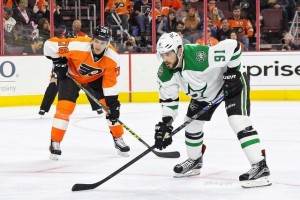
They didn’t come cheap. Overall, Nill’s acquisitions average a cap hit of almost $3.2 million per season. That is in addition to all of the players lost to trade (which admittedly aren’t that impressive for the most part).
Nill wanted mountains of offense from this group and they didn’t disappoint in that regard. This group scored 97 goals playing 5-on-5 this season, good for 59.5% of the team’s totals. They also put up 176 primary points which made up for over 55.5% of the team’s totals. Four players in that group had at least 10 goals playing 5-on-5 and eight of them had at least 10 primary points. They put up excellent overall numbers while making up for just 48% of the team’s overall ice-time.
This group was also able to consistently drive possession. They posted a combined 53.21 CF% and a combined 53.29 FF%. Both of those numbers were best of three GM’s in their respective categories. Similarly, they put up a combined SCF% of 53.91 and made up for almost 56% of the Dallas Stars’ scoring chances at 5-on-5.
With the offensive powers possessed in this group, they were often utilized in a way to directly produce offense. They had the highest combined amount of offensive zone starts by over 500 and had the highest combined offensive-zone-start-% (52.55) of the three groups. Ruff was superb at deploying his players in effective roles while not overly sheltering too many players.